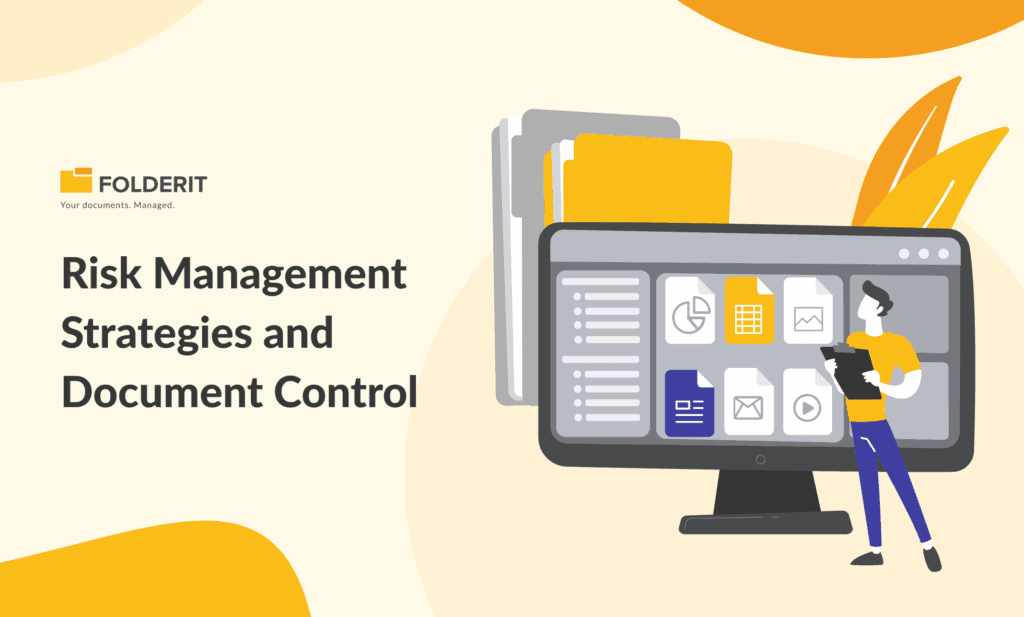The intersection of risk management strategies and document control forms a critical nexus in safeguarding sensitive information and ensuring operational compliance. As such integrating essential risk management strategies with advanced document control systems, like Folderit, is a strategic imperative for businesses to appropriately navigate the digital landscape.
Understanding Risk in Document Management:
Risk in document management is multifaceted, encompassing threats from unauthorized access, data breaches, compliance lapses, and operational disruptions. These risks can have far-reaching consequences, from financial losses to reputational damage. Identifying and mitigating these risks is crucial for any organization seeking to protect its data assets.
The Role of Document Management Systems in Risk Mitigation:
Document Management Systems (DMS) stand at the forefront of risk mitigation. They offer:
-
Access Control: Restricting document access to authorized personnel.
-
Data Encryption: Ensuring data is unreadable to unauthorized users.
-
Audit Trails: Tracking document access and modifications for accountability.
Key Risk Management Strategies for Document Control:
Effective risk management in document control is a multifaceted endeavor, requiring a blend of strategic foresight, technological integration, and organizational commitment. Here are some detailed and practical strategies that organizations can implement to manage risks in document management:
1. Comprehensive Risk Assessment:
-
Conduct thorough risk assessments to identify potential vulnerabilities within the document management process. This involves evaluating the likelihood and impact of risks related to data breaches, compliance failures, unauthorized access, and operational inefficiencies.
-
Utilize tools like SWOT (Strengths, Weaknesses, Opportunities, Threats) analysis to understand internal and external risk factors.
2. Robust Access Control Mechanisms:
-
Implement strict access control policies to ensure that only authorized personnel can access sensitive documents. This includes setting up user authentication protocols, such as multi-factor authentication, and role-based access controls.
-
Regularly review and update access permissions, especially when employees change roles or leave the organization.
3. Data Encryption and Secure Storage:
-
Encrypt sensitive documents both in transit and at rest to protect against unauthorized access and data breaches. Use advanced encryption standards like AES (Advanced Encryption Standard) for maximum security.
-
Opt for secure cloud storage solutions with reliable data centers and backup systems to prevent data loss due to physical disasters or system failures.
4. Regular Compliance Audits and Updates:
-
Stay on top of regulatory changes and ensure that your document management practices comply with industry standards and legal requirements, such as GDPR, HIPAA, or SOX.
-
Schedule regular compliance audits to identify any gaps in your document management system and take corrective actions promptly.
5. Version Control and Document Tracking:
-
Implement version control to maintain the integrity of documents. This ensures that all modifications are tracked, and the latest version of a document is always available.
-
Use document tracking systems to monitor who accessed or modified a document, providing an audit trail for accountability and traceability.
6. Employee Training and Awareness Programs:
-
Conduct regular training sessions for employees to educate them about the importance of document security, risk management practices, and compliance requirements.
-
Foster a culture of security awareness where employees are encouraged to report suspicious activities or potential risks.
7. Disaster Recovery and Business Continuity Planning:
-
Develop a comprehensive disaster recovery plan to ensure business continuity in the event of a cyber-attack, system failure, or natural disaster. This includes having off-site backups and a clear recovery protocol.
-
Test and update your disaster recovery plan regularly to ensure its effectiveness.
8. Continuous Monitoring and Improvement:
-
Continuously monitor the document management system for any unusual activities or potential risks. Use monitoring tools and software to detect anomalies in real-time.
-
Adopt a continuous improvement approach to refine and enhance your document management and risk management strategies over time.
By implementing these detailed and practical strategies, organizations can significantly mitigate risks associated with document management, ensuring the security, compliance, and efficiency of their document handling processes.
Successful Risk Management in Action:
Practical use cases illustrate the effectiveness of integrating risk management with document control. For instance, a healthcare provider can successfully implement a DMS to manage patient records, ensuring HIPAA compliance and reducing the risk of data breaches. Another example is that a legal firm that utilizes a DMS to streamline case file management, enhancing data security and improving response times in legal proceedings.
Technological Advancements and Their Impact on Risk Management:
Emerging technologies like AI, ML, and blockchain are revolutionizing risk management in document management. AI and ML offer predictive analytics for identifying potential risks, while blockchain provides an added layer of security and transparency. These advancements are shaping a future where document management is not only more secure but also more intelligent and efficient.
Challenges and Considerations in Implementing Risk Management Strategies:
Implementing risk management in document control is not without its challenges:
-
Integration Complexity: Merging new systems with existing workflows can be complex.
-
User Resistance: Change can often meet with resistance from staff accustomed to traditional methods.
-
Cost Implications: Upgrading to advanced DMS can involve significant investment.
Folderit's Approach to Risk Management in Document Management:
Folderit's DMS exemplifies how technology can enhance risk management in document control. Key features include:
-
Custom Access Permissions: Tailoring document access based on user roles to prevent unauthorized access.
-
Audit Trails: Providing a comprehensive log of who accessed or modified a document and when.
-
Automated Alerts: Notifying relevant personnel about document changes or compliance requirements.
-
Secure Cloud Storage: Offering robust encryption for stored documents, ensuring data security and privacy.
-
Workflow Automation: Streamlining processes to reduce human error and enhance efficiency.
Conclusion:
The integration of risk management strategies with document control is crucial for any organization aiming to protect its data and ensure compliance. The advancements in technology, particularly in DMS like Folderit, offer powerful tools to manage these risks effectively.
Organizations must continually assess and update their document management practices to stay ahead of risks. Embracing comprehensive risk management strategies, supported by advanced systems like Folderit, is key to achieving long-term success and sustainability in the digital era.



